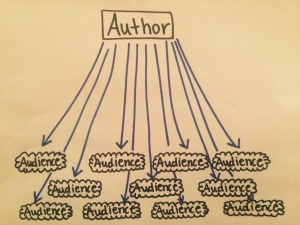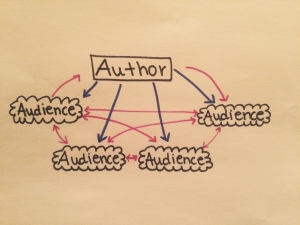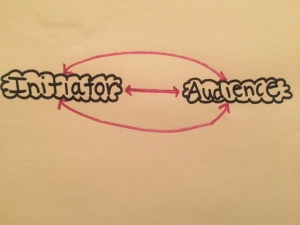I began this week’s discussion questions with the intention of completing my first Vlog in order to address the importance of face to face communication that Turkle refers to in her book, Alone Together. As I read Chapters 6-8 (and part of 9) and began research about AI scientists, I found myself making connections to other videos/texts and I had many ideas of what to include in my response this week. I experimented with a few “takes” of my video, but I didn’t feel that I was getting my point across clearly and effectively. After much time, thought, and reflection I have decided to complete this week’s discussion response in a blog format in order to include all of the visuals, video, and links to articles that I would want my audience to interact with. I will leave vlogging to another time, perhaps next week with our discussion of identity, control, and hiding.
There are many modes of communication that we navigate daily. In this portion of my response I will delve into four: presentations, discussions, conversations, and internet-only communication.
The Presentation: The presentation as I know it is a direct stream of information from an author/superior to an audience with the intention that the recipients will learn about a topic or concept. In my experience, I fairly consistently find presentations at building based Professional Development sessions that are intended to educate faculty on a new initiative, policy, or way of teaching/assessing. Recently I have viewed a presentation for OSHA Training and the updated teacher evaluation rubric in my district. Perhaps my most recent example of a productive and meaningful presentation was at convocation this year when the superintendent shared funny and interesting videos in his Prezi presentation to engage, entertain, and inspire teachers at the beginning of the school year. Using additional media in presentations certainly increases the enjoy-ability and retention of a presentation from the audience’s perspective.
Below, please see my illustration of the power dynamic that exists in a presentation form of communication.
In this mode of communication, the power is entirely in the hands of the presenter. Presentations remind me of an old-school way of teaching where the teacher is the “sage on the stage” and the students absorb information.
The Discussion: The discussion is a more collaborative (yet formal) structure to present information and elicit feedback and ideas from the audience. Like a presentation, the author of the communication content is in control to lead the discussion and provide a context, however in this form of communication the audience has a larger role. The audience members/participants are provided with the opportunity to interact with each other and the author to gain a deeper understanding of the content.
 In my experience, I have participated in discussions in larger group settings, and we are often given prompt/question to discuss and then share out to larger group so that we can come to a deepened group consensus and understanding. In my role as team leader at my school, I am responsible for leading discussions with my colleagues on certain topics using protocols that I have learned from my study of the book The Power of Protocols by Joseph P. McDonald.
In my experience, I have participated in discussions in larger group settings, and we are often given prompt/question to discuss and then share out to larger group so that we can come to a deepened group consensus and understanding. In my role as team leader at my school, I am responsible for leading discussions with my colleagues on certain topics using protocols that I have learned from my study of the book The Power of Protocols by Joseph P. McDonald.
The discussion is a communication tool that has adapted well to an online format. Resources like Google+, Google Chat, Google Hangout, and blogging have made our participation in discussions more deliberate, planned, and thorough. I think the nature of online discussions encourage participants/audience members to be more thoughtful and take more time to respond than a face to face discussion would allow. One drawback, however, is that we lose nuances like tone and expression that in person discussion provides.
Below, please see my illustration of the power dynamic in a discussion. The author is in control of the content, and can shift the course of the communication, but the audience has a larger role.
The Conversation: The conversation is something that Sherry Turkle might refer to as the lost art in modern communication. Face-to-face communication is the most informal, personable, and perhaps meaningful and connected way of communicating that I will discuss here. In a conversation there is a shared control of the topic, nature, and tone of the communication. There is more opportunity to listen, react, and respond to another person. I have conversations in my professional and personal life constantly (as do all teachers). Every day I have conversations with my team members, colleagues, students, administrators, husband, parents, siblings, and friends. Some of these conversations are in person, and some are had over the phone, through texting, emailing, or online. I personally prefer in person conversations, but sometimes that is not possible due to time and logistical constraints.
Below, please see my illustration of the power dynamic in a conversation. There really is no author, really an initiator who begins the conversation. Both members are equal contributors and have the ability to guide the communication.
Internet-Only Communication: Online communication is perhaps the mode of communication in which the author has the most control. In this way of communicating, the author has control not only of the content, but of the viewer’s impression of the author. The author controls the images/avatars the the audience will see and interact with, and if the author does not like the commentary that comes from the audience, he/she has the option to delete or ignore it.
In Chapter 9 of Alone Together, Turkle presents the struggle that students face to create online identities for each phase of their lives: the transition to middle school, high school, and college. Turkle writes, “Each [identity] serves a different purpose, but they must overlap, or questions of authenticity will arise. Creating the illusion of authenticity demands virtuosity. Presenting a self in these circumstances, with multiple media and multiple goals, is not easy work.”
Turkle also discusses the online world of Second Life in Alone Together. I don’t think anyone can explain Second Life better than Dwight K. Shrute from the NBC Original Series (and my favorite show), The Office.
Second Life, Facebook and other social media communication outlets allow authors of the communication the ultimate control to manipulate communication and reality in order to create new identities, protect vulnerabilities, or have total control over the perception of others.
Below, please see my illustration of a power dynamic in an online communication. Here, the author has the ultimate control, and can choose whether or not to accept communication from the audience.



